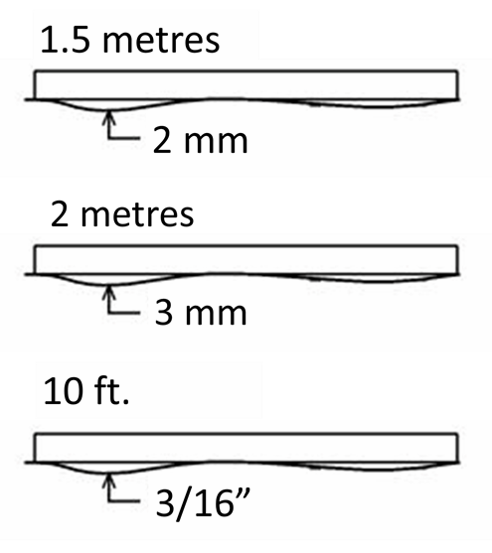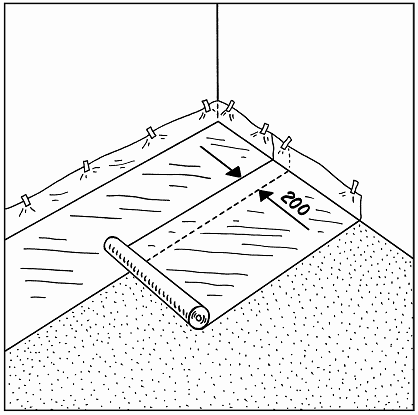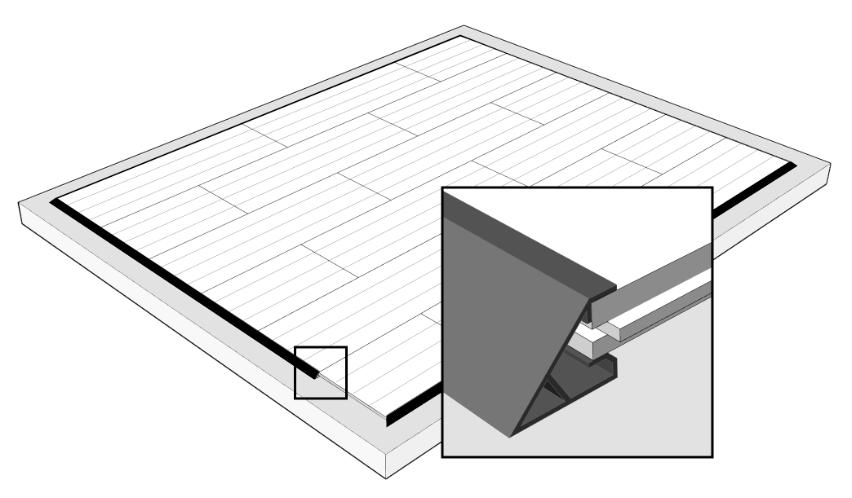A3 PORTABLE SPORTS FLOOR
SPECIFIER'S AND INSTALLATION INSTRUCTIONS
D 3.1
D 3.1
INFORMATION A3 PORTABLE FLOOR
|
D 1.0 |
General information |
|
D 3.1 |
Specifier's and |
Table 1
1. SYSTEM SPECIFICATION
Junckers Portable A3 Sports floor is based on 22 mm solid hardwood floorboards, prefabricated into light weight panels.
The panels are laid floating on a 10 mm resilient foam underlay.
Construction height: 32 mm.
Each floor panel is easily locked into position with factory fitted metal brackets.
Lengthwise the panels have a tongue and groove connection and at ends the panels are joined using loose tongues.
For faster and more flexible installation ask for Junckers CenterRow Panels that makes two way installation possible.
Performance:
The floor system is categorised as an area elastic with medium shock absorbency and elasticity suitable for fitness and aerobics as well as a temporary sports floor, e.g. with special line markings for a given sports game. The floor system fully conforms to EN 14904:A3.
Flexible installation - CenterRow panels:
For faster and more flexible installation ask for Junckers CenterRow Panels that makes two way installation possible.
Transition ramp: A supporting and protecting transition ramp forms a strong edge to the floor perimeter.
Storage carts: Junckers custom designed storage carts make transportation and storage of the panels easy.
Read all information: Please note that full documentation of a this floor system comprises General information and Specifier's and Installation instructions, see table 1.
2. GENERAL REQUIREMENTS
Climatic Conditions:
The relative humidity in the building should be between 35 and 65 %. The temperature should be between 18 and 25 °C. The system must be stored and/or acclimated in the same climatic environment in which it will be installed, in order to avoid initial cupping of the panels due to sudden changes in the relative humidity.
Time frame for use
The portable A3 floor is recommended for short term use of up to 10 days. For long term use, we recommend the floor system Arena Master or Pro Complete 44 System.
Flatness of the subfloor:
The subfloor must be flat according to recommendation in section 8, Flatness of the subfloor.
Backstops and heavy equipment
If portable backstops will be placed on the floor, plywood blocking must be used in lieu of the foam in the area beneath the backstop. Typically, a 2.4 x 2.4 m plywood footprint matching the thickness of the foam is required for each portable backstop.
When moving heavy equipment across the floor, i.e., backstops and scissor lifts, 1 layer of 18 mm plywood “tracks” must always be used to protect the playing surface.
Painted areas and on-site applied lacquer
For heavily painted areas and floors with on-site applied lacquer, a roller application method must be used. To prevent / minimize sidebonding of the panels, the floor must be disassembled within the first 72 hours after paint / lacquer has been applied.
Use a utility knife to score the paint / lacquer to create a clean break between the panels the first time the floor is disassembled. Keep recommended Paint / lacquer consumption per m².
3. FLOOR COMPONENTS - A3 PORTABLE FLOOR
- Junckers 22 mm 2-strip solid
hardwood floor panels
Wood species, grade and surface:
Beech Premium silk matt lacquered.
Width x length:
Full size panel: 513 x 1800mm
Half size panel: 513 x 900 mm - Assembly brackets
Prefixed metal brackets - Intermediate layer
Junckers Sports Foam - SylvaThene Moisture barrier on concrete
0.20 mm PE-membrane - Transition ramp
Black painted aluminium
Fig. 1

4. LOAD-BEARING STRENGTH OF THE SYSTEM
Load-bearing strength of the system depends on the type of load, see table 2. See also data sheet D 1.0 - Stiffness and load-bearing strength of floors.
|
Table 2 |
Loading types |
|||
|
System |
Area load |
Point load |
Point load |
Wheel load |
|
A3 |
1.000 kg |
350 kg |
400 kg |
See D 1.0 Table 1 |
5. CHOICE OF SUB FLOOR
Subfloors must be self-supporting and can be made of concrete, lightweight concrete, screed or in connection with renovation be an existing sports floor with e.g. a synthetic or wooden floor surface.
The elasticity of the subfloor has a direct impact on the properties of the completed floor in terms of deflection, impact absorption and ball bounce. In renovation projects the elasticity and load bearing strength of the existing floor must be assessed in relation to the use of the floor.
If the floor area is made of several types of subfloors, it must be of uniform elasticity and flatness, to ensure a uniform performance of the sports floor.
6. BEFORE BEGINNING TO INSTALL THE FLOOR
The building must be weather tight. The heating system must be installed and tested, and during the heating season there should be a constant heat supply.
Cast concrete elements, including casting of sockets for fixtures and fittings, screeding and other wet trades which can contribute moisture to the building, e.g. priming of paintwork, must also be completed.
The relative humidity in the building must be within the relative humidity interval expected, when the building is in use and the room temperature approx. 20°C.
7. MOISTURE PROTECTION
Concrete subfloors
The residual moisture contained in the concrete or screed must not exceed 90% RH.
(UK: Concrete moisture max. 75% RH acc. to BS 8201, when checked by measurement).
At ground and upper levels protection against moisture both from within the building and from the ground is required.
A moisture barrier is established by laying a damp-proof membrane, 0.20 mm PE membrane or 1000 g polythene, e.g. Junckers SylvaThene Moisture Barrier, directly on the concrete.
Wooden subfloors
The moisture content of a wooden subfloor must be in balance with the relative humidity of the room, i.e. moisture content of 6-12%.
For renovation projects where floating floor systems are laid on existing wooden subfloors, it must be ensured that the entire structure has been designed to the correct specifications regarding moisture.
Usually, no additional moisture protection is laid on top of an existing wooden floor as this may course the risk of fungal attacks in the sub construction.
8. FLATNESS OF THE SUBFLOOR
The subfloor must be levelled so that any deviations in the flatness do not conflict with the requirements of the method stated below.
Straight edge:
The subfloor must be flat with a maximum deviation of 2 mm under a 1.5 m straight edge.
(UK: 3 mm under a 2 m straight edge).
(US: 3/16” under a 10 ft. straight edge).
Deviations are measured as gaps under the straight edge. The surface must be smooth. Any irregularities must be corrected by grinding or by using a self levelling compound.

9. INTERMEDIATE LAYER - SPORTS FOAM
As intermediate layer for a Junckers A3 portble sports floor, use Junckers Sports Foam.
If the subfloor is fully or partly inelastic Junckers 10 mm Sports Foam is used, while for elastic subfloors, e.g. existing sports floors with certain resilient properties, Junckers 5 mm Sports Foam is used.
For more information, see Junckers Sports Foam H 3.3.
10. NET CONSUMPTION OF MATERIALS
Net consumption for a 608 m² basketball court according to the official FIBA rules 19 x 32
metres (including a 2 metres safety zone around the court):
Full size panels: 665 pcs.
Half size panels: 38 pcs.
Loose tongues: 703 pcs. (Including 38 extra)
Sports Foam: 632 m² (9 rolls of 75 m²)
SylvaThene moisture barrier, 0,2 mm PE-foil: 632 m² + waste. (7 rolls. of 100 m²)
Extracting hook: For extracting loose tongues when dismantling the floor.
Optional:
Center Row panels.
Transition ramp.
Storage carts. One cart stores 40 full size panels.
The calculated floor area:
The calculated m² of the floor will due to the floor panel size in most cases be slightly larger than the specified floor area.
HOW TO INSTALL THE FLOOR
1. MOISTURE BARRIER
A moisture barrier of min. 0.20 mm PE membrane is laid, e.g. Junckers SylvaThene Moisture Barrier.
The moisture barrier is laid with an overlap of 200 mm at all joints.
The polythene has to be taped at all lap joints using a tape 50 mm vide.

2. SPORTSFOAM
Junckers Sportsfoam mat is laid parallel to the laying direction of the panels with joints fully closed and taped in place.
Floors subject to heavy loads
Heavy loads from e.g. portable basketball stands, etc., the resilient foam along the perimeter of the floor can be replaced by plywood.
This prevents undesirable deformation of and thereby damage to the panels, see Fig. 2.1.

3. INSTALLATION - FIRST ROW
Keep 500 mm distance to walls and fixed installations to allow free access around the floor and to mount loose tounges.
The first row of panels is laid in a straight line with the assembly frame pointing in the laying direction.
The panels are joined at ends using loose joining tongues, see drawing.
First time the floor is laid all the panels should be numbered on the back side or on the assembly frame, to ensure that they are placed correct each time the floor is laid, so that line markings, etc. are aligned.

4. INSTALLING - THE FOLLOWING ROWS
The panels are laid in an interlocking pattern so that all end joints are staggered 900 mm from row to row.
The panels are pressed close together in lengthwise tongue and groove joints before they are pressed down into the assembly bracket using e.g. a rubber hammer.
Panels without the assembly bracket are used for the last row.

5. SUPPORTING TRANSITION RAMP
The supporting and protecting transition ramp forms a strong edge of the floor perimeter.
Start with the 8 corner profiles and then adjust the ramp. Use a rubber hammer if necessary.
Make sure the ramp is in correct position in order to support the panels (see small picture).

6. FLEXIBLE INSTALLATION - CENTER ROW PANELS
Centre Row panels are available on request with this floor type.
These panels come with metal brackets on each side and are laid out in the middle/centre of the floor as a starting row.
In this way two installation teams can work at the same time.

7. DISMANTLING THE FLOOR
Start by removing the ramp in the perimeter of the floor.
Remove loose joining tongues using the extracting hook, and dismantle the panels row by row starting with the last installed panel.
Carefully take up the panels and stack them in the storage carts. Space the individual panels to ensure optimum ventilation.
The Sports Foam is rolled up and stored in an upright position.

